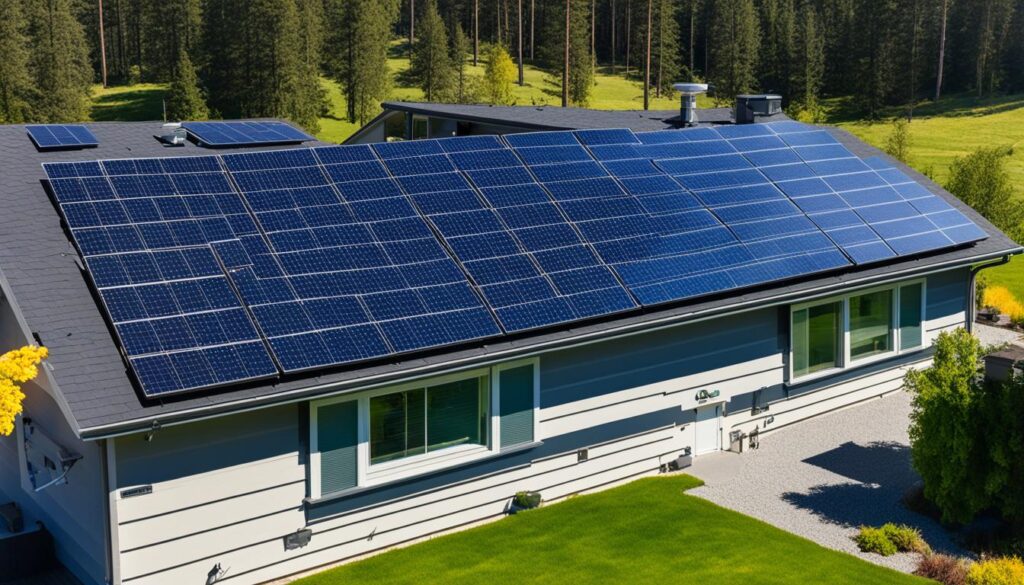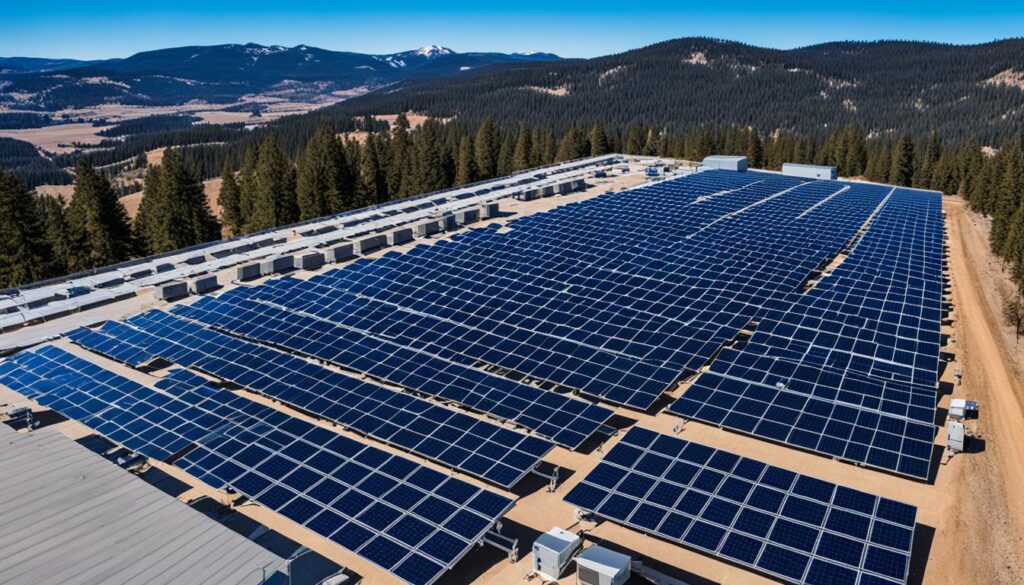A 10kW solar system is a big source of power, making 30-50 kilowatt-hours (kWh) of electricity per day in India. It depends on where you are, the weather, and how well the system is set up. This amount of energy works well for regular homes or small businesses that use about 35-40 units of electricity each day.
With a strong mounting structure, you can put this system on your roof, whether it’s concrete or has sheeting. You can even set it up in fields. The system includes residential solar panel efficiency, energy storage, and the equipment to turn sunlight into power you can use. There’s a special part, the 3-phase inverter, that changes the energy from the panels sunlight to electricity conversion for your home’s devices.
Key Takeaways
- A 10kW solar system can produce 30-50 kWh of electricity per day in India.
- This system is suitable for average urban homes or small businesses that consume around 35-40 units of electricity per day.
- The 10-kilowatt solar panel combines energy storage and renewable energy production in one package.
- The 3-phase inverter converts DC from the grid into AC, allowing you to use your home’s existing electricity supply.
- The 10kW solar system can be installed on concrete rooftops, sheet roofs or in open fields.
Understanding 10kW Solar System Production
To really get what a 10kW solar system can do, you have to first know the difference between power and energy. A KiloWatt (kW) tells you how much power an appliance or solar panel makes. It’s like saying 1kW is one thousand watts. In India, most homes need between 24,000 to 48,000 watts at any time. KiloWatt Hour (kWh), on the other hand, is about the energy used over an hour. Your utility bill shows this, and it tells you how much energy your home uses each month.
Factors Affecting Solar System Output
Solar panels have a power output label, but they don’t always produce that much power. The label comes from tests in perfect conditions in the factory. But things like the Sun’s angle and the season affect how much power your panels actually make. To pick the right size of system, look at your yearly power bill, how much sun your area gets, and what part of your bill you want your solar to cover.
Location and Solar Hours
Where you live is huge in how much solar energy you can get. For example, Ohio gets about 4.68 hours of good sunlight a day. In contrast, Florida enjoys 5.77 hours. More sunny hours mean Florida residents have more chances to collect solar energy. Ohio folks, with fewer hours, have to work harder to use their available sunlight. This gap in available sunlight affects how efficient your solar panels are and the size of the solar system you need.

| Location | Average Solar Hours per Day | Solar System Size Needed |
|---|---|---|
| Ohio | 4.68 hours | 10 kW |
| Florida | 5.77 hours | 8 kW |
The table shows that Florida needs a smaller solar system than Ohio, for the same energy. This tells us how much your location and the Sun’s power matter when you pick a solar system.
How Much Does a 10kW Solar System Produce Per Day?
Understanding a 10kW solar system’s output is vital. Daily energy generation and the renewable energy yield matter. The photovoltaic system output changes with the weather conditions, seasonal changes, and the geographic location.
Average Daily Output
A typical 10kW solar kit makes 30 to 45 kilowatt-hours (kWh) each day. This equals about 11,000 to 17,000 kWh a year. Your solar panels’ efficiency is key to daily energy generation.
Seasonal Variations
Solar energy production changes with the seasons. Summers bring more daylight and solar irradiance, boosting output. Winter can lower daily energy generation since days are shorter and the weather may not be as good.
Location-Based Differences
Where you install solar panels affects the renewable energy yield. A Miami home, with 5.77 solar hours per day, could need an 8kW kit for 13,000 kWh yearly energy. Yet, a Cleveland home, with 4.68 solar hours per day, might need a 10kW kit for the same energy level.
Conclusion
A 10kW solar system helps you manage your home’s energy use and cuts how much you rely on usual power sources. It starts saving you money the first day it’s put in because it meets most of your energy needs with solar energy production. If you’re on net metering and tied to the local grid, you might even earn solar credits. This is because your system sends extra solar energy units to the grid.
Looking long term, the benefits of choosing solar energy are much more than the initial cost of 10kW solar panels in India. A solar setup will likely pay for itself in 6 to 8 years. After that, the solar energy generated is free for your use. With a 10kW solar system, less of your power comes from the usual grid. This makes it a clean energy source. It’s also a sustainable power generation choice for homes or small businesses.
FAQ
How much does a 10kW solar system produce per day?
A 10kW solar system in India makes 30-50 kWh daily. This depends on where you live, the weather, and how efficient your setup is. It’s good for homes or small businesses using 35-40 units of power daily.
What is the difference between kW and kWh?
A kilowatt (kW) is the power an appliance uses or a solar system produces. rooftop solar array capacity equals 1000 watts. A kilowatt-hour (kWh) shows how much energy a kilowatt uses in one hour. This is what your utility bill measures each month.
What factors affect solar system output?
Weather, season, and location impact how much energy a solar system makes. For example, Ohio’s sun shines about 4.68 hours a day, while Florida enjoys 5.77 hours. This means in Florida, an 8 kW system makes as much as a 10 kW in Ohio.
How does location impact a 10kW solar system’s daily output?
The solar system’s output changes based on where it is. In Cleveland, a 4.68-hour average means a 10 kW system can cover the whole electric bill of a home. Yet in Miami, with 5.77 hours of sun, an 8 kW system can do the same job.
What are the long-term benefits of a 10kW solar system?
Choosing a 10kW solar system helps manage your energy use and lessen reliance on traditional power. You’ll save on bills from day one and may earn solar credits. In India, your solar panels can pay for themselves in 6 to 8 years. After that, your energy is mostly free.

